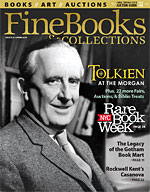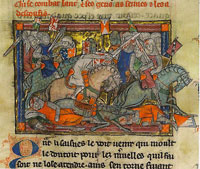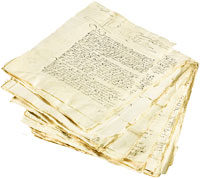 Ian McKay’s weekly column in Antiques Trade Gazette has been running for more than 30 years.
Ian McKay’s weekly column in Antiques Trade Gazette has been running for more than 30 years. Manuscripts to Movie Scripts
A queen’s correspondence, presidential proclamations, and Indiana Jones, all featured in the major auctions of late 2010.
Illuminated Knights of the Round Table
The Rochefoucauld Grail, a fourteenth-century illuminated manuscript, £2,393,250 ($3,731,315) at Sotheby’s London on December 7.
Containing over one hundred miniatures illustrating aspects of warfare, chivalry, and courtly love, this was a stunning and early example of the first large-scale work of secular literature.
Individual parts of the story of the search for the cup used by Christ at the Last Supper had first appeared in late twelfth century, but it was not until the composition of the Lancelot-Grail Cycle, in the opening decades of the fourteenth century, that the story reached a fully developed form. Combining the story of Joseph of Arimathea’s journey to England with the Grail and tales of Arthur, Merlin, Lancelot, and the other Knights of the Round Table, this hugely popular epic set the mould for the entire romantic genre until the late Renaissance.
This monumental illuminated manuscript on vellum, was probably produced in Saint Omer, Tournai, or Ghent, and though as seen at Sotheby’s it comprised just three volumes, it was once a four-volume set, the final volume now being split between two English libraries.
Perhaps made for Guy VII, Baron de la Rochefoucauld (who died in 1356 at the Battle of Poitiers), it remained in the family and complete until it was divided up and sold in the early eighteenth century. The second and third volumes were acquired at £43 by the greatest manuscript collector of them all, Sir Thomas Phillipps (who in 1815 had bought the first volume at Sotheby’s). More recently they have been owned by another well known collector, J. R. Ritman, founder of the Bibliotheca Philosophica Hermetica in Amsterdam.
The Captive Queen
Letters relating to the imprisonment of Mary, Queen of Scots, £349,250 ($550,630) at Sotheby’s London on December 7.
Yet another ex-Phillipps lot, this time part of the Lord Hesketh sale mentioned in last month’s issue, was a cache of letters, unknown to earlier historians and biographers and in large part unpublished, relating to the long captivity of Mary, Queen of Scots.
The forty-three autograph, copy, or draft letters dated from the years 1584-85, by which time Mary, whose Catholic faith, lack of diplomatic skills, and unwise choice of lovers, had been imprisoned for years—much of the time in the charge of the Earl of Shrewsbury.
The cache includes four letters signed by Elizabeth I, one bearing the autograph superscription, “use but olde trust and new diligence.” Seventeen of the letters (two of them autographed) were signed by her first minister, advisor, and spymaster, Francis Walsingham.
There is also a letter from the Earl of Leicester to Walsingham and six draft or copy letters (including one from Elizabeth to Mary) in the hand of John Somner, secretary to Sir Ralph Sadler, the man who had been given the thankless task of taking over custody from Shrewsbury. At a time of bloody religious wars in France and the Low Countries, open hostility from Spain and even Catholic plots against Elizabeth in England with which Mary’s name was inevitably associate, meant that Sadler’s new post of keeping the country’s most dangerous prisoner was not one he would have welcomed.










